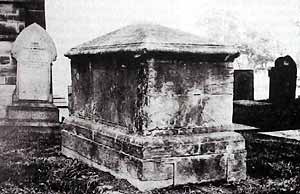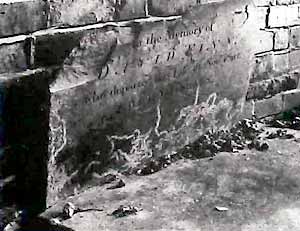< Previous
TALES FROM ST STEPHEN'S CHURCHYARD:
The preacher, the fiddler and the tailor
By Stephen Best
 TOMB OF THE REV. EDWARD WILLIAMS.
TOMB OF THE REV. EDWARD WILLIAMS.SNEINTON CHURCHYARD is, as most local people know, much older than the present St Stephen’s church. Among its memorials are several recalling people who were buried when the much-patched and, by all accounts, very dilapidated mediaeval church stood here. A casual onlooker might think that there were very few burials before the nineteenth century, but it should be remembered that only a small minority of families would be able to afford the cost of a headstone, and that consequently most of those who lie in the churchyard have no marked grave. Descriptions of the churchyard in the time of the old church are rare, but one such was provided by John Throsby, in his revision of Robert Thoroton's 'Antiquities of Nottinghamshire'. Writing in the 1790s, Throsby observed of Sneinton; 'Here is a chapel, a member of St Mary's, Nottingham, dedicated to St Stephen, where service is performed once a fortnight. In the chapel yard are some tombs and a number of grave stones: of the former is one to the memory of Edward Williams, a dissenting minister, who was esteemed for his excellent disposition; he died possessed of a large fortune, in 1787 . . . Of the latter, one covers the remains of Mr William Frud, eminent as a dancing master and as a violin player; and esteem'd, in the polite circles of Nottingham and Leicester, for his amiable disposition. He died in 1787, age not mentioned'.
By great good luck both of these memorials survive to this day. Near the corner of the church closest to The Fox public house, and just to the east of the stone in memory of Thomas Stevenson the Sneinton blacksmith, is a prominent chest-tomb, with a lid whose four sloping triangular sides rise to a central point. Careful examination of this memorial reveals the names of Mary and the Rev. Edward Williams. This is one of only a handful of table tombs in Sneinton churchyard which remained intact after the mysterious collapse of a number of them in 1931. It was said locally that the proceeds of a robbery had been hidden in a memorial in the churchyard, and that would-be thieves had demolished the tombs in an attempt to find this swag. A rumour certainly went the rounds, after the sacking of Colwick Hall in 1831, that its looters had concealed some of their booty in the churchyard, and I incline to the belief that the damage to the memorials took place after the Nottingham press had marked the centenary of the Reform Riots with an account of the Colwick robbery and its possible aftermath.
To return, though to the Rev. Edward Williams. The best account of him appears in Benjamin Carpenter's history of High Pavement Chapel, Nottingham*, to which I am indebted for much of the following information. Williams arrived in Nottingham in 1750 from Hampstead, armed with a letter of introduction to Dr Eaton, minister of High Pavement Chapel. This stated that Mr Williams, 'a gentleman of great piety and learning, and a solid, judicious preacher', had come into a considerable fortune left to him by a relative. He had thereupon given up a chaplaincy in Hampstead and set off to visit Lancashire, where he had an estate (bequeathed, presumably by his kinsman), before settling in Nottingham, 'He will', said the letter of introduction, 'be ready to preach for you upon emergency, and to do you all the service that lies in his power.' Although he was never formally engaged at High Pavement - with his private income he had no need of a stipend - Mr Williams occasionally assisted Dr Eaton and his successors, and for a number of years preached regularly at Ilkeston. In the discharge of this duty be became known for his reliability in turning up; 'Riding in all weathers through a rough country with bad roads, and attended by his man-servant, of whom he was often much more careful than himself.' The Rev. Edward Williams comes down to us as a most attractive figure, and it is not surprising that he was 'universally respected for his benevolence and worth'.
To the south of the Williams tomb is another one similar to it, though retaining some of its original railings, embellished with elegant urns. The identity of the person commemorated here is, unhappily, now lost, but it seems likely that it was someone of substance. However, we have a real discovery close by, as compensation. Right up against the railings just described is a simple flat stone slab bearing a rather rudimentary incised arch framing this inscription: 'W Frudd, died May XXX 1791'. This is of course not the date quoted by Throsby, but, despite his writing so soon after the event, he got it wrong. It may have been a simple slip of the pen; 1787 was the date of Edward Williams's death, and it would have been easy for Throsby to repeat it inadvertently. Frudd, to be strictly precise, departed on May 29th 1791, his passing finding a mention in the diary of Abigail Gawthern of Low Pavement; she wrote simply, 'Mr Frudd, the dancing master, died May 29.'
William Frudd had been conspicuous in local musical circles for over twenty years. An advertisement in 1766 showed him to be teaching dancing at Sarah Moore's boarding school for young ladies at Bramcote, and it is evident that he led a busy life attending academies, conducting dancing schools, and giving private lessons. In 1773 Frudd organised his own benefit concert at the Ladies’ Assembly Room, Nottingham, and from that year he gave dancing lessons at the Old Assembly Room, Derby. His ability as a violinist was widely recognised: in 1785 William Frudd was engaged as first violin for Richard Roe’s benefit concert in Derby. Roe was a schoolmaster, and secretary of the Derby Philosophical Society: some idea of the importance of this occasion can be gained from the fact that he hired for his benefit not only Frudd, but also Samuel Harrison, one of the leading tenors of the day. Before noting his death in 1791, Abigail Gawthern had jotted down brief details of two of Frudd's social functions attended by her. On November 15th 1775 she was 'At Mr Frudd's ball; 50 scholars', and on May 21st 1789 she noted: 'Mr Frudd's ball; took Anna.' Anna was Mrs Gawthern's daughter, then aged about five, so the ball may have been less grand that it sounds: no doubt Frudd's pupils were being put through their paces.
As with the Rev. Edward Williams, one gets the feeling that William Frudd must have been an agreeable man. The Nottingham Journal obituary notice of June 4th 1791 more than bears out this impression: 'On Sunday evening died, at his house on the High Pavement, Mr William Frudd. Benevolence was the ruling principle of his heart, and his chief delight was to do good. He lived respected, and died universally regretted.'
 INSCRIPTION IN MEMORY OF DAVID FINN.
INSCRIPTION IN MEMORY OF DAVID FINN.From these two memorials which were recorded in the eighteenth century, we turn to one that has, so far as one can tell, never been mentioned in print before; one, moreover, which has survived by the skin of its teeth. Against the Dale Street boundary wall, almost opposite the vicarage, stands a damaged slate tablet which reads; 'To the memory of David Finn, who departed this life, 16th Novr 1802, aged XLV years.' Several years ago, while restoration work in the churchyard was under way, the present writer came upon this tablet lying face downwards and resembling nothing more than a lump of useless masonry. Prompted by an obscure impulse, I peered at the underside of the slab and discovered the inscription. It was hastily put in a place of safety before being given its present location by Family First, who were carrying out the work in the churchyard. The inscription is, as already mentioned, damaged, and I think that it lacks its top line. I hazard a guess that the slate tablet used to adorn one of the table tombs in the churchyard; one of those, perhaps, which fell down so mysteriously in 1931. And Mr David Finn - was he worthy of rescue from oblivion? I think he was. The Nottingham Journal of November 20th 1802 reported his death, describing him as 'an eminent merchant-taylor, of Pelham Street'. Mr Finn had been active in business earlier in 1802, advertising in the Journal for journeymen. Abigail Gawthern did not overlook Finn’s demise. She wrote: 'Mr Finn died, Nov 16; he was a noted tailor and a very disloyal man.' It must be emphasised here that by 'disloyal', Mrs Gawthern meant anyone who did not adhere to her own brand of fiercely unflinching toryism, which burned brightly in the politically deeply-divided Nottingham of the 1790s. Willoughby's directory of the town for 1799 listed David Finn as a 'Habit maker and tailor, Gridlesmith Gate'. This old street name disappeared at the beginning of the nineteenth century, with the adoption of the name 'Pelham Street'. Pelham was a family name of the Dukes of Newcastle, whose importance was also reflected in the nearby Clumber Street (named after their seat), and Clinton and Lincoln Streets (Newcastle courtesy titles and surnames). The Finn tailoring business must have been well thought of: in 1782 the Mayor, on behalf of the Corporation, paid Finn 18 shillings for '2 Green Livery Coats making'. Not long before his death, David Finn was in trouble with the authorities, being fined 2/6d in 1800 for inflicting 'a most unpardonable Encroachment upon the street by making an enormous Bow Window projecting over the long row two feet or thereabouts.' In addition to paying the fine, Mr Finn, had to ensure that the offending window was reduced to the size of neighbouring shop windows. Just as property owners today may curse the Sneinton Environmental Society for preventing the erection of stone cladding, or the removal of chimney stacks, so must David Finn have anathematised the interfering busybodies who took exception to his splendid window.
I HAVE IN THIS ARTICLE gently rapped John Throsby over the knuckles for his mistake over the date of William Frudd’s death. Let me, then, make speedy apology for my error in 'Tales from St Stephen’s churchyard - 2' in Sneinton Magazine no. 30. By misreading my own notes I called the Rev. William Butler’s wife Anne, instead of Jane. Anyone who has been to look at the gravestone will already have noticed my mistake.
Not for the first time, the reader is recommended to look at 'The diary of Abigail Gawthern of Nottingham, 1751-1810', edited by Adrian Henstock, Thoroton Society, 1980. This is a splendidly entertaining slice of Nottingham life, full of prejudice, liveliness and gossip. The introduction gives an admirable picture of the town which Messrs Williams, Frudd and Finn knew.
*Some account of the original introduction of Presbyterianism in Nottingham and the neighbourhood, with a brief history of the society of Protestant Dissenters assembling on the High Pavement in that town. London & Nottingham, 1860.
< Previous
